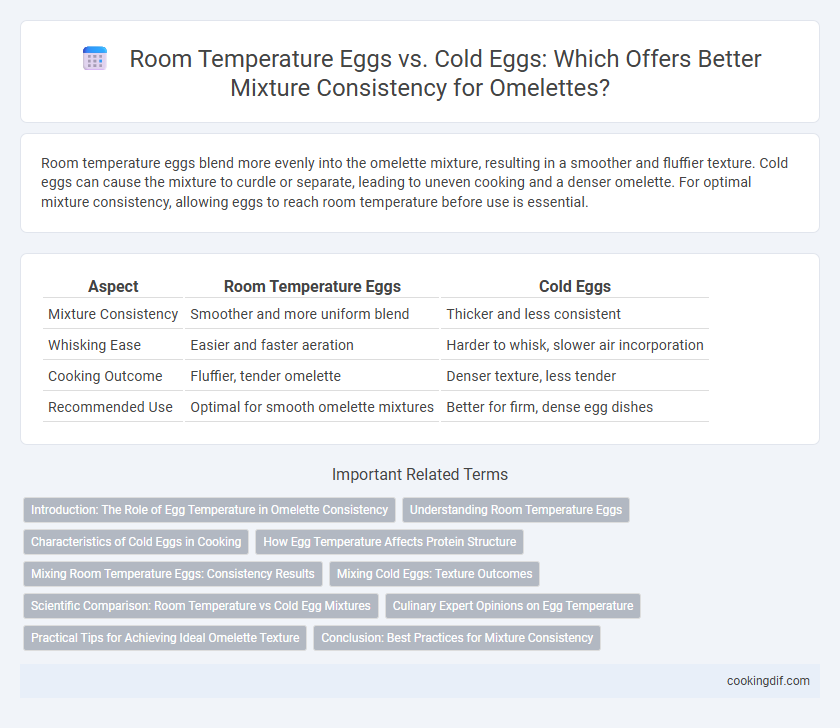Room temperature eggs blend more evenly into the omelette mixture, resulting in a smoother and fluffier texture. Cold eggs can cause the mixture to curdle or separate, leading to uneven cooking and a denser omelette. For optimal mixture consistency, allowing eggs to reach room temperature before use is essential.
Table of Comparison
| Aspect | Room Temperature Eggs | Cold Eggs |
|---|---|---|
| Mixture Consistency | Smoother and more uniform blend | Thicker and less consistent |
| Whisking Ease | Easier and faster aeration | Harder to whisk, slower air incorporation |
| Cooking Outcome | Fluffier, tender omelette | Denser texture, less tender |
| Recommended Use | Optimal for smooth omelette mixtures | Better for firm, dense egg dishes |
Introduction: The Role of Egg Temperature in Omelette Consistency
Egg temperature significantly impacts the final texture and consistency of an omelette, with room temperature eggs blending more evenly due to their reduced viscosity. Cold eggs from the refrigerator tend to resist homogenization, resulting in a slightly denser mixture and uneven cooking. Using room temperature eggs enhances the mixture's smoothness, promoting a fluffier and more consistent omelette texture.
Understanding Room Temperature Eggs
Room temperature eggs blend more uniformly into omelette mixtures, resulting in a smoother texture and consistent cooking. Their chemical properties allow proteins to incorporate air better, enhancing fluffiness compared to cold eggs directly from the refrigerator. Using room temperature eggs optimizes emulsification, improving the overall consistency and mouthfeel of the finished omelette.
Characteristics of Cold Eggs in Cooking
Cold eggs from the refrigerator often result in a thicker, less homogeneous mixture due to the increased viscosity of the egg whites and yolks. The lower temperature can cause the proteins to coagulate unevenly, affecting the smooth texture desired in an omelette. For consistent blending and a fluffier outcome, allowing eggs to reach room temperature beforehand is recommended.
How Egg Temperature Affects Protein Structure
Egg temperature significantly impacts the protein structure during omelette preparation, with room temperature eggs promoting better protein denaturation and matrix formation. Cold eggs retain firmer protein structures, resulting in less uniform mixtures and reduced emulsification capacity. Consequently, using room temperature eggs yields a smoother, fluffier omelette texture due to enhanced protein interactions.
Mixing Room Temperature Eggs: Consistency Results
Mixing room temperature eggs results in a smoother, more uniform omelette batter, allowing better integration of ingredients compared to cold eggs. At room temperature, egg proteins mix more easily with other components, improving emulsion and reducing the risk of curdling during cooking. This consistency enhances the texture and appearance of the omelette, making it fluffier and more evenly cooked.
Mixing Cold Eggs: Texture Outcomes
Mixing cold eggs directly from the refrigerator results in a denser, less aerated omelette due to the slower integration of air into the mixture. Room temperature eggs incorporate more air when beaten, producing a lighter, fluffier texture in the final dish. Therefore, allowing eggs to reach room temperature before mixing enhances the omelette's consistency by improving volume and tenderness.
Scientific Comparison: Room Temperature vs Cold Egg Mixtures
Room temperature eggs blend more uniformly with other ingredients, resulting in a smoother, more consistent omelette mixture due to reduced viscosity and quicker emulsification. Cold eggs, with higher viscosity from lower temperature, can cause curdling or uneven texture when mixed with warm ingredients. Scientific studies show that warming eggs to around 20-22degC optimizes protein unfolding, enhancing mixture homogeneity and final omelette fluffiness.
Culinary Expert Opinions on Egg Temperature
Culinary experts emphasize that room temperature eggs blend more uniformly, resulting in a smoother omelette mixture compared to cold eggs straight from the refrigerator. The even temperature facilitates better emulsification of egg whites and yolks, enhancing texture and fluffiness during cooking. Cold eggs often cause uneven mixing, leading to a less consistent omelette consistency and potential cooking irregularities.
Practical Tips for Achieving Ideal Omelette Texture
Using room temperature eggs for an omelette results in a smoother, more uniform mixture that cooks evenly and yields a tender texture. Cold eggs can cause the batter to be uneven, leading to a denser omelette with inconsistent fluffiness. For best results, let eggs sit on the counter for 15-20 minutes before whisking to optimize mixture consistency and achieve the ideal light, creamy texture.
Conclusion: Best Practices for Mixture Consistency
Room temperature eggs blend more uniformly with other ingredients, resulting in a smoother omelette mixture and even cooking. Cold eggs tend to resist integration, causing a lumpy batter that affects texture and fluffiness. For optimal consistency, whisk eggs at room temperature to achieve a delicate, airy omelette with consistent cooking throughout.
Room Temperature Eggs vs Cold Eggs for mixture consistency Infographic

 cookingdif.com
cookingdif.com